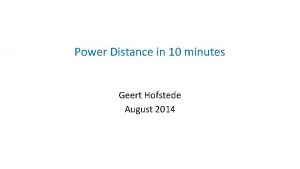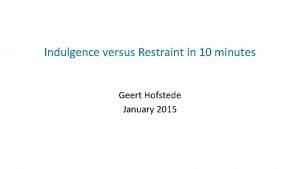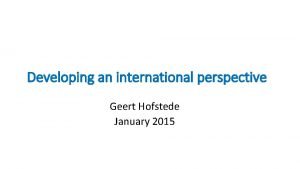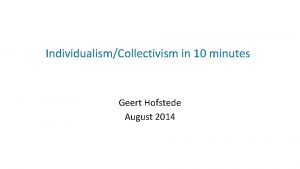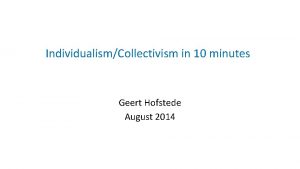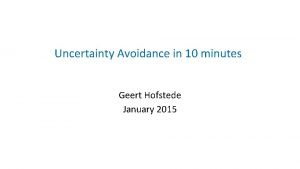Power Distance in 10 minutes Geert Hofstede August








- Slides: 8

Power Distance in 10 minutes Geert Hofstede August 2014

Origin of the term “power distance” • Used in the 1960 s by Dutch experimental social psychologist Mauk Mulder for describing interpersonal power differences • In the 1970 s, applied by Hofstede to differences between national societies

Power Distance as a societal culture dimension • Extent to which the less powerful members of institutions and organizations expect and accept that power is distributed unequally • Transferred to children by parents and other elders 3

Large Power Distance Small Power Distance • Inequality is normal • Superiors are superior beings • Power comes before good and evil • Children should learn respect as a key virtue • Centralization • Subordinates expect to be told • Inequality is wrong • Hierarchy is for practical purposes • Use of power should be legitimate • Children should learn to be independent • Decentralization • Subordinates expect to be consulted

How are societal power distances measured? • There is no absolute standard for power distance • “All societies are unequal, but some are more unequal than others” • What we can measure is differences between national societies • The position of societies relative to each other is expressed in a Power Distance Index score (PDI) • PDI values have been plotted on a scale from 0 to 100; scores close to 0 stand for a smaller, scores close to 100 for a larger power distance

Some Power Distance Index (PDI) scores, out of 76 High 93 Russia 81 Mexico 80 China 80 Arab countries 77 India 68 France 54 Japan Low 50 Italy 40 U. S. A. 38 Netherlands 36 Australia 35 Germany 35 Britain 18 Denmark

Some examples of what these PDI scores correlate with High PDI societies • More income inequality • Smaller middle class • Dictatorships or oligarchies • Violence in national politics • Political systems changed by revolution • Business executives older • Innovations only when supported by hierarchy Low PDI societies • Less income inequality • Larger middle class • Separation of powers • Peaceful conflict resolution • Political systems changed by evolution • Business executives younger • Spontaneous innovations by mavericks or rebels

Don’t the scores change over time ? • The scores are based on values transferred from parents to children; these values rarely change after adulthood • Research bij Sjoerd Beugelsdijk comparing answers to the same questions by two successive generations 30 years apart shows a worldwide shift towards slightly smaller power distances • However, the position of countries relative to each other remained the same; and this is what the scores are based on • Country differences expressed in the scores are often rooted in centuries of history • So, the scores can be assumed to be stable over time
